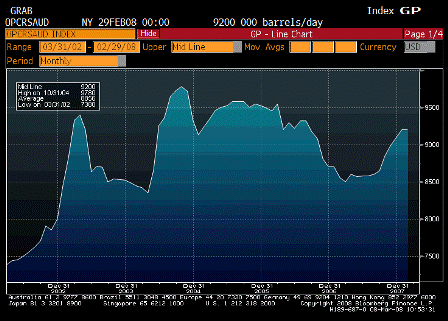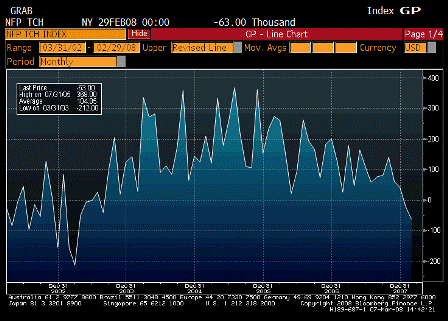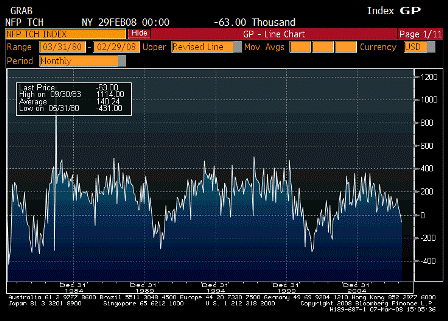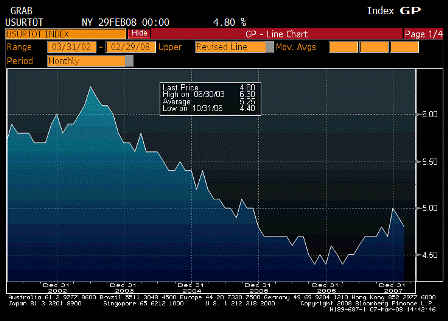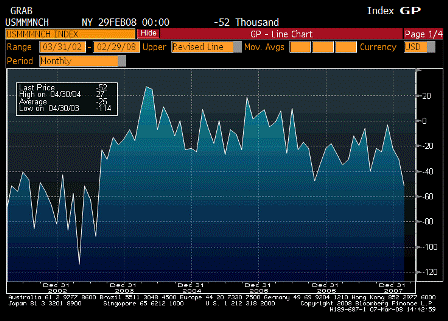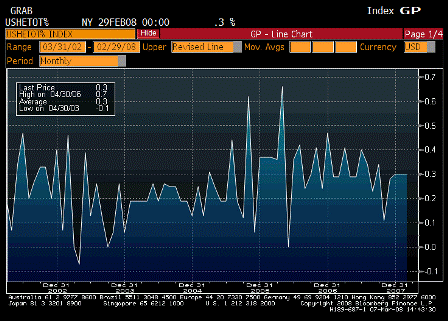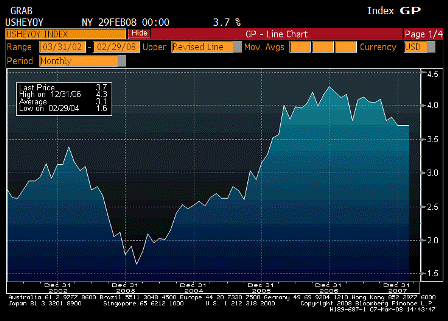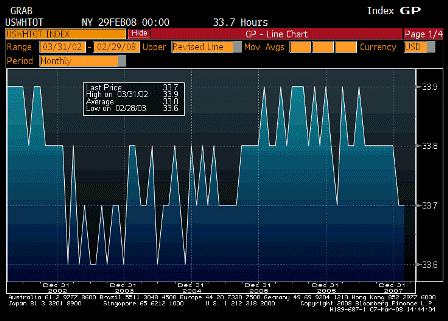4:20 pm Eastern time, March 6
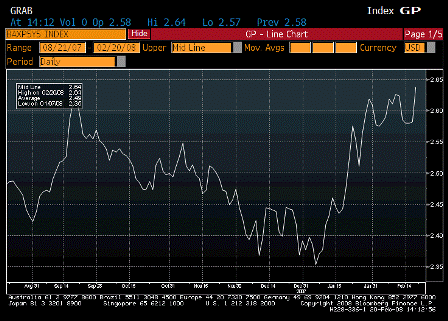
TIPS 5y5y fwd
Twin themes remain since Q2 2006: weakness and inflation.
Weakness:
The great repricing of risk continues driving credit spreads wider, bid/offer spreads wider, volumes lower, and market forces continue to drive a general, massive deleveraging in the financial sector.
Housing is very weak: sales and construction are down more than 50% from the highs.
Unemployment is up a few tenths, and domestic demand in general is subdued.
Overall, strong exports keep us out of recession, and the real economy muddles through with GDP near zero.
Inflation:
Crude back up through $105, and the $ index down big to all time lows, driving up import prices and external demand (and rising export prices), and our own pension funds are driving up commodity prices by allocating funds to passive commodities.
CPI is up about 4.5% year over year, and core is moving up towards 2.5% as well.
The Fed
The Fed strategy has been to cut rates as an expression of doing what’s necessary to help the financial sector’s problems from spreading to the real economy.
The Fed sees a risk of a massive, 1930’s like, output gap and deflation. They see no reason to worry about the current 4.5% inflation when a potential 10%+ deflation/depression is looming, and with their models forecasting lower inflation.
And as they see inflation expectations remaining now ‘reasonably well anchored,’ and futures markets indicating lower prices for the out months vs the spot months, the Fed’s models continue to forecast lower inflation in the months and years ahead.
Policy is necessarily formed on forecasts, not rear view mirror observations, even if those forecasts have been continuously wrong for the last year. As a point of logic, there is no choice but to continue to forecast to the best of their ability and to continue to formulate policy around those forecasts.
Unfortunately, things have gone awry.
Rather than adding to demand and supporting GDP through the anticipated monetary and credit channels, the Fed’s rate initial rate cuts instead have seemingly driven the $US down and raised the price of imports, particularly energy.
With nominal wages ‘reasonably well anchored’ this has acted as a tax on the consumer and further reduced domestic demand. Falling real wages did coincide with increased exports, but not enough to keep GDP from falling ‘below trend’ and the output gap somewhat wider than it was previously.
Further rate cuts did the same – drove the $ down/prices up further, and reduced real wages and domestic demand. And further increased exports just enough to keep GDP near zero.
And the ‘credit crisis’ continues.
And inflation expectations have elevated. Note the attached chart of 5 year TIPS 5 years forward. The Fed has indicated this is one of their important indicators of inflation expectations and was taking comfort that it had been reasonably well anchored up to a few months ago. Now it’s just passed previous all time highs.
Even the Fed doves have recently said inflation is above their comfort zones, and they have been qualifying their support for rate cuts with statements like ‘if oil prices fall or remain at current levels’ when crude was around $100 or less.
Here’s the problem for the Fed:
They rely on output gaps to bring inflation down to their comfort zones. When they see even tail risk of major deflationary forces setting in they feel more than justified in addressing that risk of an excessive output gap that would not only slow inflation but bring on outright deflation.
But as inflation persists and expectations become less well anchored, the Fed believes the required output gap to bring inflation back down increases substantially, as their most recent studies show that it takes ever larger moves in interest rates to alter unemployment, and ever larger moves in unemployment to alter inflation.
Should housing simply stop contracting, and housing prices only level off, tail risk of an output gap large enough to cause a massive deflation fades.
Suddenly, the forecast output gap, while positive, is far too low to bring inflation and inflation expectations back into the Fed’s comfort zones.
The Fed is already out on the fringes of mainstream economics, including the text books Bernanke and Mishkin have written.
Mainstream economics says that if you are at full employment (believed by the Fed to be a 4.75% unemployment rate) when faced with rising energy costs that drive up prices and reduce consumer demand, leave it alone.
Don’t cut rates and add to demand, and turn a relative value story into an inflation story.
Instead, let demand weaken, let GDP fall, so that other prices will remain stable and and only relative value adjusts as markets allocate by price.
If you do support demand with rate cuts, you only drive inflation higher, real wages fall anyway, inflation expectations elevate, and the real cost of then stopping/reversing this process and bringing inflation back down is far higher than if you had left it alone.
In fact, that’s what all Fed members said continuously up to last August. In recent testimony, for example (see recent postings on this website), Bernanke said the Fed didn’t cut rates because there was an inflation problem.
If crude stays at current levels or continues higher (which I suggest it will as Saudis/Russians continue to act as swing producers, and demand remains far higher than needed for them to continue to support prices at current levels), all inflation measures will continue to march higher.
And with oil producers and other foreigners now spending their $ revenues rather than holding $US financial assets, exports keep rising and keep the current output gap from widening.
For the Fed, this means the MNOG (minimum non-inflationary output gap) needed to bring inflation down to comfort zones goes up substantially.
Their current MNOG could now very well be substantially higher than the current output gap (unemployment was last reported at 4.9%).
And this MNOG beast seems to be growing by the day.
So today’s news of initial claims coming down some, retail sales showing some Feb recovery vs Jan, pending home sales flattening, muni markets reorganizing and selling bonds again, and the ISM bouncing back yesterday, and mainstream companies in general reporting reasonably good to excellent current earnings, all indicate the MNOG is growing faster than the current output gap is growing.
And less than 60 days away are the $150 billion in tax rebate checks.
For the Fed, however, ‘deflationary spiral’ tail risk remains, particularly if you see the risks as those of the 1930’s gold standard days. Back then, the supply side of credit would abruptly shut down for both the private and the public sector, and financial sector issues were immediately transmitted to the real economy. (It doesn’t work that way with today’s non convertible currency and floating exchange rate regime, where public sector spending is not operationally constrained, but the Fed doesn’t yet seem to see it that way.)
Today’s equity markets contribute to the Fed’s tail risk fears- they see the stock market as a reliable leading indicator.
The equity markets are under pressure from both directions: a weak economy is bad for business and a rebound means higher interest rates from the Fed.
And with a Fed that believes the only tool it has to fight tail risk deflation is changing interest rates (see Bernanke testimony), it is rational for markets to expect the Fed to toss another big chunk of raw meat to the MNOG with another big fed fund rate cut after the March 18 meeting.
Data dependent, of course.
Payrolls tomorrow. Jan revision probably more relevant than the Feb number, as the pattern has been for substantial revisions a month after the initial announcement.

